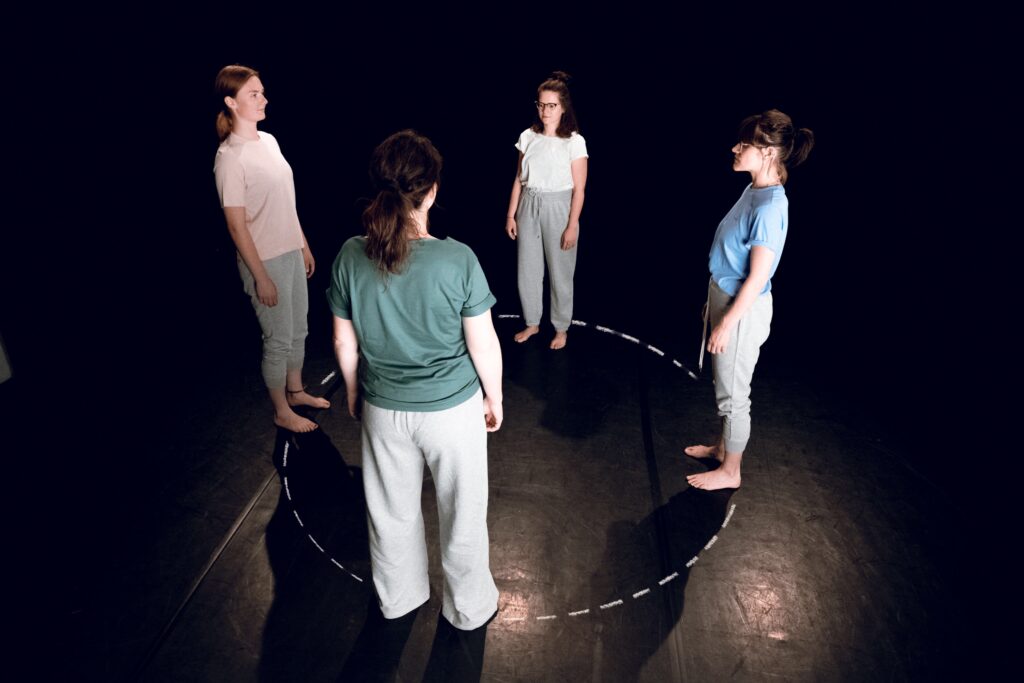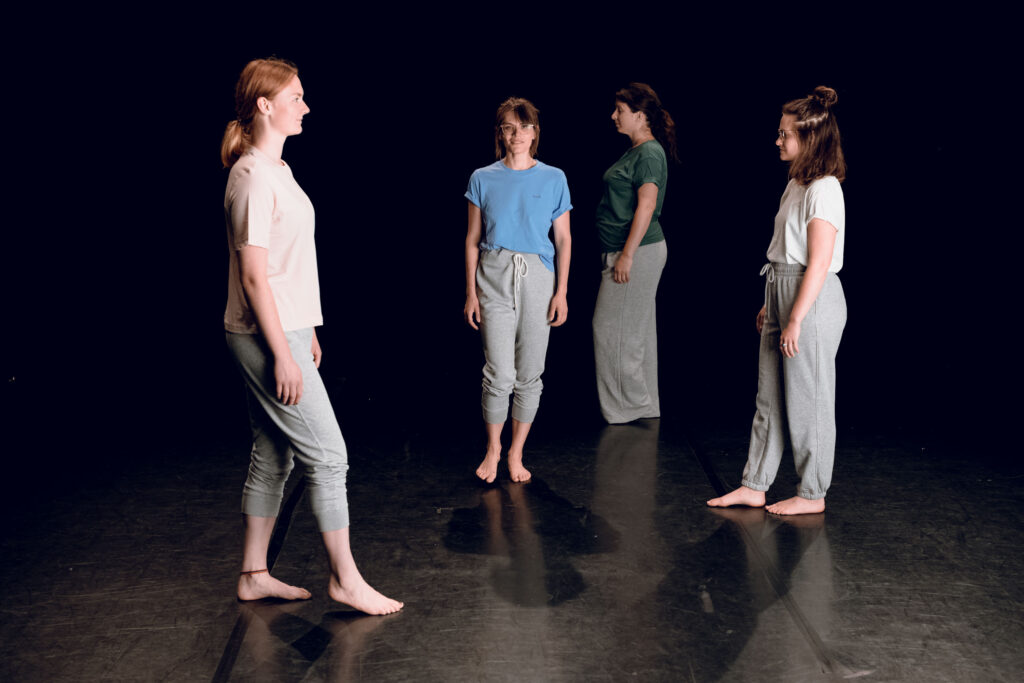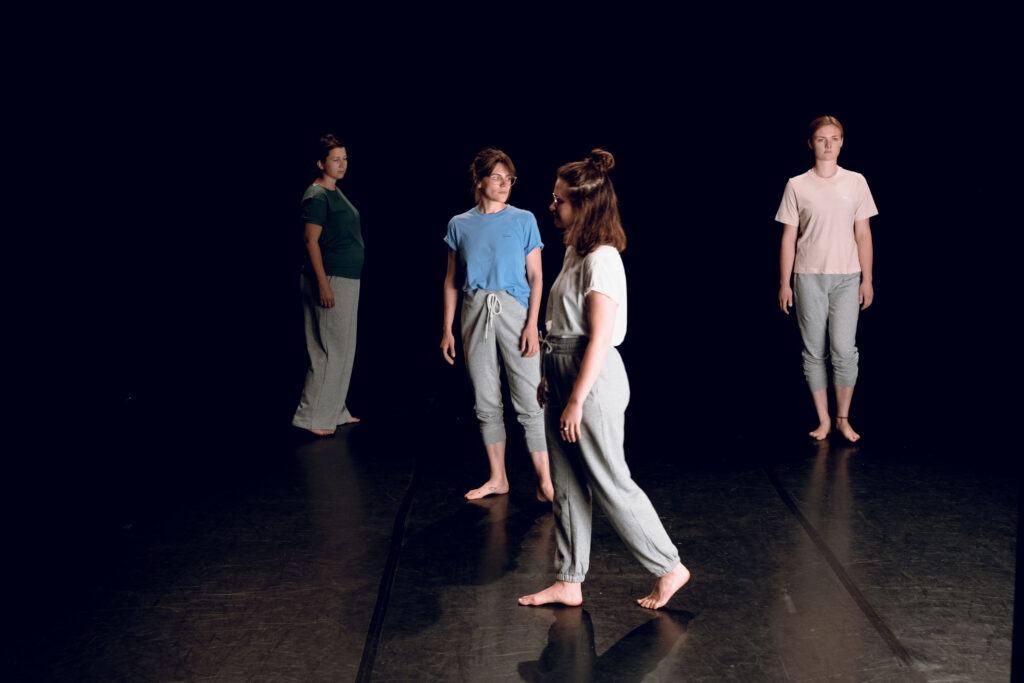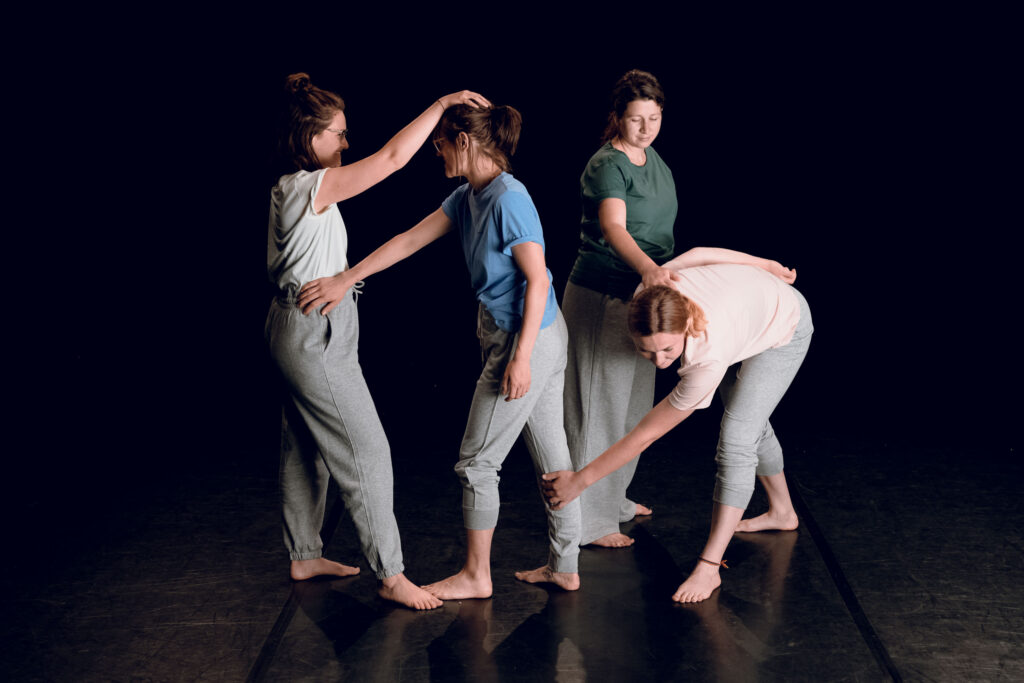As mentioned in the chapter Embracing the obstacle, I see the moment of “the obstacle” as one of the most important elements of theatrical creation. Therefore, I will handle all the following steps from the perspective of this element.
A) Listening through the whole body and 180° peripheral vision
Form a circle. Stand in the neutral position. There should be no tension in your bodies. Eyes are open. Tell everybody to keep the feeling of “peripheral vision”, being aware of the wider picture without directly observing it. Now we can see the space ahead of us at a 180° angle. Everybody looks far in front of them, melting their vision. Let’s take a moment. (2 min)
Relax. Now you can ask the members of your group to share what they have experienced. People usually say that they heard a sound they had not noticed before. Great! So, we can say that when we put the eyes on an equal level with the other senses (through practising peripheral vision) other senses can get sharper!

What we are exploring:
In theatre we need to listen through our whole body, with all the senses without one dominating the others. This is what we mean by the term “extreme listening” when used in relation to the body. (Anne Bogart calls it “extraordinary listening”)
- From now on we will always be aware of this ability.
- Obstacle: Avoiding the point of fixation and using only our peripheral vision gives us a new way of perceiving the world around us.
B) Walking exercises
1. Working with the information coming from outside: You are standing still in a circle. Use your peripheral vision. Wait until something from outside (it can be a sound, movement, light, etc.) gives you the impulse to move. Do not move just because you feel it is time to move! Wait for that impulse; it can take a little while. One member of the group gets this impulse and starts walking and others follow. Everybody should walk the way they usually walk. “Do not do pantomime!” Remind the participants to keep using their peripheral vision. “There is a thread pulling you up to the sky, you have strong legs, shoulders wide, both arms are at your sides, no other arm movements.” Tell the group to listen to the sounds in the room. They should try to use all the space in the room. Tell them to go to spots where there is nobody.
Stop the action at some point. Ask the members of your group to share what they have experienced. Usually, people realize that they are gathering in the middle of the room. Why? Because there were many activities to handle at once. It is hard to avoid, but it is just like this in our daily lives as well as in theatre. We need to be aware of many elements at the same time at every single moment.

What we are exploring:
- Applying many elements at the same time
- Making ourselves busy with a very specific activity
- Awareness of all simultaneous activities
- Feedback, how we reflect on what we experienced
- Obstacle: Not being allowed to move before something or someone gives the impulse
2. Equality in the group: Go back to walking. Try to create an equal speed within the group. Listen to the rhythm of the steps. Let’s call this speed Level 1. Now tell the group to try Level 2. Wait until the moment when all members of the group are moving with Level 2, then tell them to speed up progressively to Levels 3, 4 and 5.After some time, go back to Level 3. Then 5… Then 1. Change the level of the speed randomly.
What we are exploring:
- How all the group members act as one body in a very short time
- Listening to each other with ears and with bodies
- Having fun
- Obstacle: Not being allowed to move at a comfortable speed
3. Counting (from the Viewpoints training): We are counting one by one in the group as we walk. Everybody is allowed to say loudly just one number at a time. If you are 12 in the group, that means that you will be counting loudly until 12. The crucial point is that nobody knows when someone else will speak. If two or more people speak at the same time, somebody else needs to start counting from 1.
First try it. Once the game is clear, you can start playing it. Remind everybody that the top of their head is pulled up to the sky, their shoulders should be set wide, and they must have strong legs and stable feet. Tell them to make no expression, but just walk.
What we are exploring:
- Awareness of any sound and movement in the room
- Instinctual and rational reactions
- Speaking loudly
- Hearing our own voice amongst other voices
- Obstacle: Being allowed to speak only when someone else is not speaking
4. Camera game: Tell the group to move at speed Level 2. Remind them to listen to their environment and switch to peripheral vision. One person stops anytime he/she gets an impulse from outside. Others follow this impulse and stop anywhere in the room. Now tell them to imagine their eyes as a camera. When the whole group stops, everybody turns their upper bodies smoothly to scan their environment within a 360° angle, as if their necks are moving cameras. Their eyes are shooting whatever they can catch at that given moment. Then tell them to return to the starting position. They stay still until they get a new impulse to start walking at speed Level 2 again.
Questions to ask: “What do you remember as the strongest moment from what you were shooting? Was there something you did not notice before? Can you share it with us?”
What we are exploring:
- Looking at the space and others from the position of a creator and choosing the elements which are personally significant
- Giving name to the specific observation and storing it in our memory
- Obstacle: Being allowed to look at the world under very limited conditions – participants need to catch as much as possible while their heads are turning around continuously
5. Making choices: Form a circle. Tell the group to wait for an external impulse to move. They apply the peripheral vision. When you hear that the group is moving at a constant speed, clap your hands. Now everybody should pick one person from the group in a way that he/she will not notice. Without changing the speed or the quality of walking, everybody should keep that person in their peripheral vision. You clap again, and everybody stops wherever they are. Clap for one last time and now everybody will move as fast as possible to their person and will touch him/her with their palms. They should move until everyone touches his/her person. Then everyone stops. Tell them to be silent, not to move and close their eyes.
After one or two minutes they can relax. Ask them what they have experienced. People usually say that when they have their eyes closed, they realize the smell, heat or other qualities of the body they were touching.
It is important to do this game several times. Before you start again, stress that the process of running to the selected person is equally as valuable as the goal, which is being still with their hands on somebody else’s body. Emphasize that people may speak, laugh, etc. until the moment they touch their person, then there should be total silence and stillness.
What we are exploring:
- Difference between stillness and movement, sound and silence
- Ability to keep the peripheral vision while walking at the same speed and having one person in that visual field all the time
- Respect for different abilities, body shapes, habits and movements
- Obstacle: Keeping a specific person in one’s visual field all the time
I think it is necessary to emphasize that in these last two games we do not create something and show it to others; instead, we invite others into our experience. This experience consists of our choices and decisions based on what surrounds us. To be able to achieve this, we must discover our relationship to the space and the other people. Only by doing this can we acquire a different perspective when experiencing reality. I believe that John Cage’s 4’33’’ is the perfect example for this. During the performance of 4’33’’, the audience perceives every single sound surrounding them since their sensations are sharpened with their heightened expectation to hear something.


